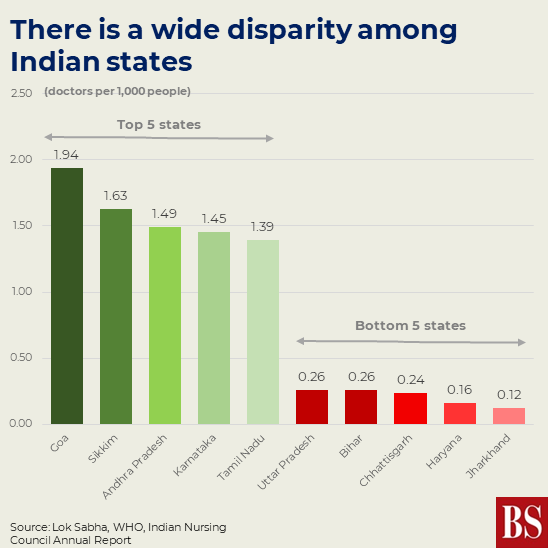India’s clear and present medical crisis: Not enough doctors, nurses
India will take 57 years to reach as many doctors per 1,000 people as OECD countries and 32 years to reach the OECD nurse-population ratio
The coronavirus pandemic has overwhelmed India’s healthcare system. Hospitals and clinics could not cope when cases piled up. Videos and images of patients and their relatives running from pillar to post in search of hospital beds, ventilators and medical oxygen have made headlines. One critical gap doesn’t get attention, though: the country’s acute shortage of doctors and nurses.
At the last count, India had 1.16 million doctors, of whom only 80 per cent or 0.9 million were working, the health ministry told Parliament in late 2019. For a population of 1.37 billion, that results in 0.68 doctors for every 1,000 people. The World Health Organization (WHO) prescribes a ratio of 1:1000. As many as 70,262 students graduated with MBBS degrees in India in 2019-20. If only 80 per cent join medical work, according to government account, it would take another seven years to reach the WHO standard. The calculation does not account for population growth. India adds 1.1 per cent to its population every year. Even if it increases MBBS seats each year by 5.5 per cent, it will still take 10 years to reach the WHO standard.
The WHO standard is the bare minimum, though. India’s partners at BRICS (Brazil, Russia, China, and South Africa) on average have two doctors for every 1,000 people. The Organisation for Economic Co-operation and Development (OECD), which has 38 members, mostly developed countries, has 3.1 doctors per 1,000 people on average. If India continues to add doctors each year at its current pace, it will take 32 years to level with its BRICS peers and 57 years with OECD countries.
India doesn’t have enough nurses, either. WHO prescribes three nurses per 1,000 people: India last year had 3.24 million nurses or 2.36 nurses per 1,000 people. The country adds 0.21 nurses to the ratio every year. At this rate, it would take two years to reach the WHO-required nurse ratio. It would take 11 years to reach the BRICS standard and 32 to get to the OECD ratio of 9.6 nurses per 1,000 people.
The disparity among India’s states is stark. A doctor graduating from a state may not work there. As a result, Uttar Pradesh has increased its count of doctors by 6 per cent in the last two years and Delhi by 27 per cent. Karnataka has added 17 per cent, whereas Bihar has not added any new doctors to its tally.
The trend is for nurses as well. Bihar did not add a single nurse to its tally between 2016 and 2018, whereas Delhi increased the count by 18.9 per cent in this period.
Rural India is almost bereft of medical care. While the country has an average of 0.68 doctors for every 1,000 people, there is only 0.1 doctor for 1,000 people in rural India.
One idea to change this might be turning government district hospitals into medical colleges. That would increase the intake of students who could be incentivised to work in rural communities.
— Ishaan Gera






